La Basse Cour: B&B near Alencon, Normandy
Normandy D-Day Beaches Self-Drive Tour
Self-Drive Tour of Normandy D-Day Beaches & Museums
D-Day Normandy Landing Beaches Tour
You can take a guided tour of the Normandy Beaches with various D-Day tour companies or hire a personal guide, but these are expensive. If you plan your own visit then you will see more than any tour offers, and you can visit sites tailored to your personal interest.
The D-Day beaches are 90 minutes from Alençon but some of our guests take a day trip to visit the Normandy Landing Beaches so we compiled this D-Day map of sites to visit. There are also Battle of Normandy sites between us and the coast, such as the Canadian War Cemetery at Cintheau (Bretteville-sur-Laize), the Polish War Cemetery at Langannerie-Urville and the Falaise Visitor Centre at Mont Ormel near Falaise, the site of the bloody German retreat from Normandy.
Use this page to design your own self-guided tour of the Normandy Landing Beaches and key sites related to Operation Overlord, the Allied Invasion of Normandy. Make sure you take advantage of the "Normandy Pass" scheme, which gives you a substantial discount on entry to the museums etc. Ask for details at any participating visitor centre.
If you have GPS we recommend you spend half an hour inputting the locations of the D-Day sites you want to visit before you set out. The great advantage is that you can choose where you want to visit from the sites on offer, and stay as long as you want at each. All sites have brochures/descriptions in English so you don't need fluent French.
NORMANDY BEACHES ACCOMMODATION BAYEUX (zoom or drag for more)
If you prefer to take a bus tour of the D-Day Beaches, there is a 4-5 hour bus tour which starts at the Caen Memorial; the tour takes you to the Arromanches Museum, the German gun battery at Longues-sur-Mer, the American Cemetery at Colleville-sur-Mer, Omaha Beach and Pointe du Hoc before returning you to the Caen Memorial. Contact the Caen Memorial for details.
A self-guided tour can take in all of the above and gives the option of visiting a number of equally memorable sites:
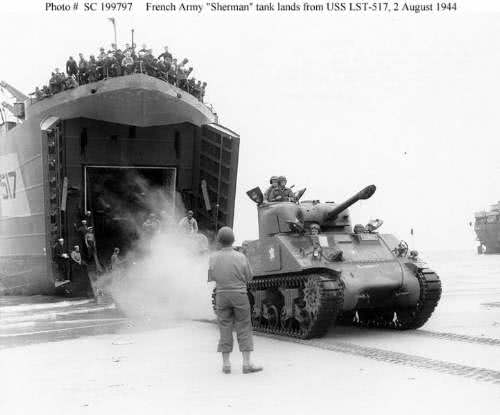
Normandy D-Day Sites
- Pegasus Bridge British Airborne Museum, Benouville
- "Le Grand Bunker" German Atlantic Wall Defence Post, Ouistreham
- German Gun Battery and 9th Paras Memorial, Merville
- Canadian Juno Beach Centre, Bernières-sur-Mer
- Arromanches 360o Cinema, Arromanches
- D-Day Landings Mulberry Harbour Museum, Arromanches
- German Gun Battery, Longues-sur-Mer
- American Cemetery, Colleville-sur-Mer, Omaha Beach
- German Gun Battery, Pointe du Hoc
- Utah Beach Museum, Sainte-Marie-du-Mont, Utah Beach
- US Airborne Museum, Ste Mère Eglise
- "Dead Man's Corner", Ste Côme du Mont
- German Cemetery, La Cambe
- British Cemetery and Battle of Normandy Museum, Bayeux
- Caen Memorial
- Canadian Cemetery, Cintheaux, Bretteville-sur-Laize
- Falaise Pocket and Mont Ormel-Coudehard Memorial
D-Day Landing Tour of Normandy Coast
The following list of the principal sites mentions more places of interest along the D-Day Tour route than can be visited in a day - pick and choose the sites to suit your personal interests and allow at least half an hour at each location.
If the history of the Resistance and the liberation of Normandy interests you, you may also like to read this account of events as they affected Ancinnes in the wartime between 1943 and 1944.
If you are making this tour starting from Ancinnes, take the A28 autoroute from Junction 19 to Sées, where you turn onto the A88 motorway and the N138 to Caen.
Arriving on the southern outskirts of Caen follow the ring road, called the 'Péripherique Est', signposted towards Paris and the Car Ferry. Keep following the Péripherique and signs for the Car Ferry. It takes 1hr 45mins to arrive at the first suggested place on the tour, Pegasus Bridge (or you can break the journey after 90 minutes and visit the Canadian Cemetery at Cintheaux, Bretteville-sur-Laize en route).
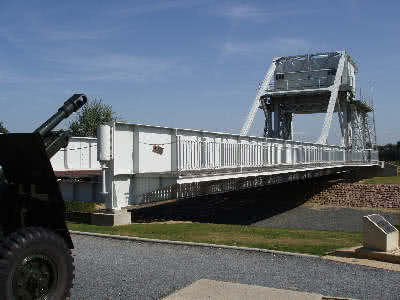
1. Pegasus Bridge, Bénouville, Normandy
Continue in the direction of Ouistreham and the Car Ferry and at Exit 3a (called "Porte d'Angleterre") of the Péripherique take the D515 to the coast, following the river Orne in the direction of Ouistreham. Turn off at the sign for Benouville and visit Pegasus Bridge: this was the site of an audacious landing by gliders of the British 6th Airborne Division in dead of night on June 6th shortly before the sea invasion, in order to secure two vital bridges. Visit the Pegasus Bridge Museum where you can see a glider, one of the bridges and displays which illustrate this remarkable story.
Nearby at Ranville the cemetery holds the graves of many British servicemen who died in this area in the days immediately following the invasion but it is hard to find - it is actually near the church.
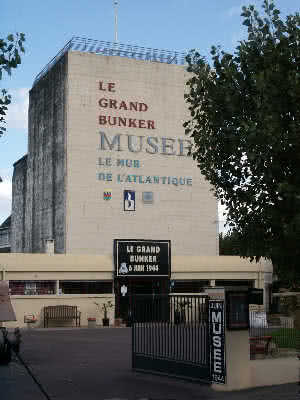
2. Grand Bunker, Ouistreham, Normandy
Continue along the D515 to Ouistreham and visit Le Grand Bunker was part of the German Atlantic Wall defences. It is located on Avenue du 6 Juin, which runs between the port and the Casino, parallel to the Boulevard Maritime. The museum is housed on the site of a German position guarding the harbour entrance that held out for days until it was eventually taken by British troops, and its rooms recreate the post as it would have been on D-Day.
Nearby is the British 4th Commando museum.
3. German Battery, Merville-sur-Mer, Normandy
Just north of Ouistreham is the German Battery at Merville-sur-Mer, another heavy artillery position guarding the port and coastline. One German gun position has been recreated and there is a 10-minute "son-et-lumière" recreation of the sights and sounds of the attack on the battery, from the massive bombing by Lancasters that announced the start of the attack, to the German shelling of Sword Beach and the harbour, to the remarkable attack on the battery by the 9th Battalion the Parachute Regiment of the British army.
The actual landing beaches run westwards from Ouistreham in the order Sword (British and French), Juno (Canadian), Gold (British), Omaha and Utah (American) and each has a number of visitor sites.

4. Canadian Memorial Centre, Juno Beach, Normandy
At Bernières-sur-Mer is the Canadian Memorial and museum dedicated to the Canadian forces who took Juno beach; one of two major Canadian war grave cemeteries is located nearby at Reviers, near Bény-sur-Mer, with a total of 2048 burials. There is an even larger Canadian war grave cemetery inland on the road from Caen to Alençon at Cintheaux, near Bretteville-sur-Laize; almost every unit of the 2nd Corps is represented here. There are 2,793 Canadian soldiers buried in the cemetery at Cintheaux, 91 of them unknown. With them lie 79 members of the R.C.A.F.
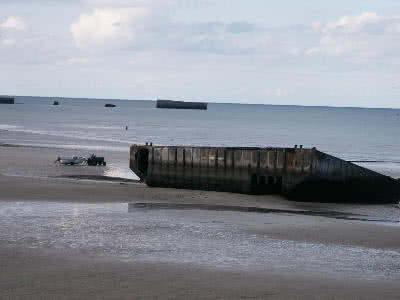
5-6. 360o Cinema and Mulberry Harbour Museum, Arromanches, Normandy
At Arromanches, on top of the cliff before you descend into the town itself, is the 360 degree cinema - there you can watch a film "in the round" which cleverly mixes archive and modern footage.
If you park at the cinema, a short walk down a cliffside path brings you to the Landing Museum built near the site of the Mulberry Harbours, which were constructed to aid the Allies in getting supplies ashore. NB There is a charge for parking at both the cinema and the Arromanches museum - park at one and walk to the other if you plan to visit both.
The Arromanches Harbour Museum has excellent exhibits, films and models to illustrate the D-Day landings and the extraordinary creation of the floating Mulberry harbour.
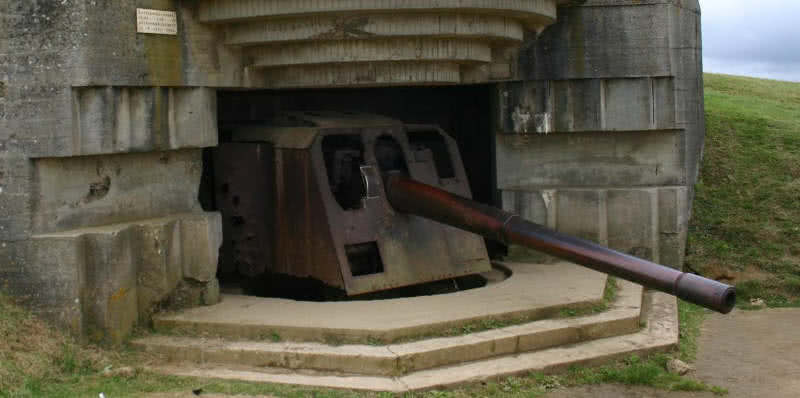
7. German Gun Battery, Longues, Normandy
West of Arromanches is the German gun battery at Longues-sur-Mer, part of the Atlantic Wall defences. A major defensive position in the Atlantic Wall, this battery had a command post and four bunkers, each with a 150-mm gun permanently in place. Located in the middle of the assault sector and on top of a cliff overlooking the Channel, it played a strategic part in the Allied Landings of June 6th, 1944. Longues Battery is the only one in the region to have kept its guns; because of its excellent state of preservation it is well worth a visit.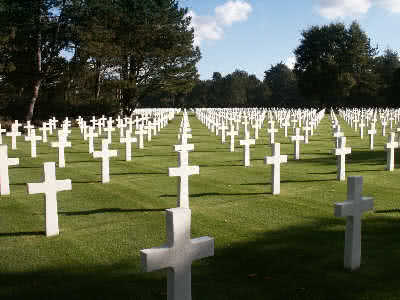
8. American Cemetery, Omaha Beach, Normandy
Further along the coast at Colleville-sur-Mer you arrive in the American sector where you can visit the American Cemetery, overlooking Omaha Beach. It closes at 5.00pm each day with the playing of the Last Post by a bugler.

9. Point du Hoc, Normandy
From the American Cemetery continue along the coast to Point du Hoc - site of a daring raid by American Rangers who scaled the cliffs to attack a strategic German gun battery. You can see where the guns were and massive crater holes caused by the advance Allied bombardment - you also get panoramic views of the coast in both directions, this dominant position explaining why it was important that this battery was taken out early in the day.
Nearby at Grandcamp there is a small museum on the seafront road dedicated to the Rangers who took and held Point du Hoc.
10. Utah Beach Museum, Sainte-Marie-du-Mont, Normandy
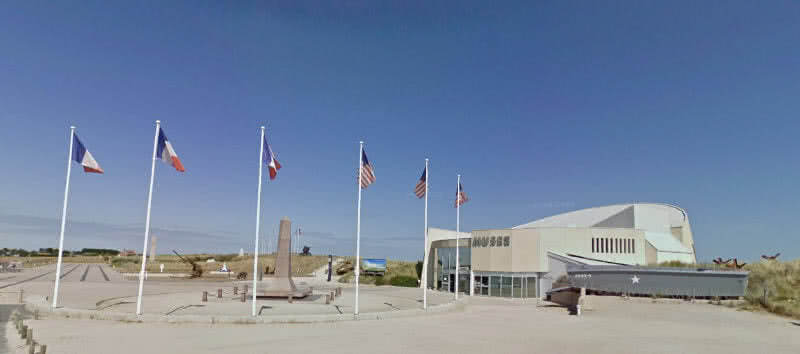
From Point du Hoc if you venture further along the coast past Isigny and Carentan you arrive at the Utah Beach Museum at Sainte-Marie-du-Mont. The Utah Beach museum tells the story of the American landings and fighting to control this sector. The displays include actual landing craft used by American troops during the Normandy landings.
11. US Airborne Museum, Ste Mère Eglise, Normandy
A few kilometres inland is the village of Ste Mère l'Eglise. Here is the church where a wounded American parachutist famously hung from the spire for hours before being dragged inside by German soldiers who were hiding there. A slightly macabre dummy hangs from the spire and there are a couple of beautiful stained glass windows commemorating the American parachutists who liberated the town after fierce fighting. There is also a museum dedicated to the airborne divisions who dropped in this area on D-Day, exhibits including a WACO glider and Douglas C-47 airplane.
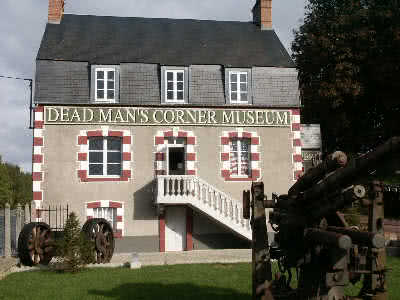
12. Dead Man's Corner, Ste Côme du Mont
Near the neighbouring village of Ste Côme du Mont is the place known as Dead Man's Corner, now a superb little museum with an excellent memorabilia shop. This spot was named after an American soldier whose tank was disabled by German guns on the corner where the house stands, which was a German command post on the important road from the coast to Carentan. The soldier's dead body remained hanging from the turret until the Americans finally overran the command post - hence the name of the site. The house contains a lot of personal effects donated by American soldiers who landed at Utah Beach and their families.
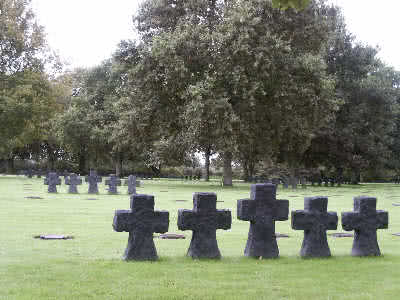
13. German Cemetery, La Cambe, Normandy
On the N13 road back to Bayeux and Caen is the German cemetery at la Cambe (do not confuse it with a second German cemetery at Orglandes further west of St Mère l'Eglise). The understated scale of the monument and the sombre granite grave markers make a strong contrast with the American cemetery.
14. British Cemetery and Battle of Normandy Museum, Bayeux, Normandy
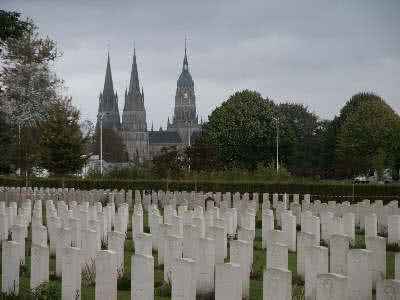
At Bayeux is the largest British and Commonwealth WW2 cemetery in France. It holds not only the remains of almost 4,000 British soldiers but also those of 181 Canadians plus a smaller number of Australians, New Zealanders, South African, Poles, Frenchmen, Czechs, Italians, Russians and 466 Germans.
Over the road a memorial bears the names of 1,808 Commonwealth soldiers whose bodies remain missing. Also near the cemetery is the Bayeux War Museum, which tells the story of the Battle of Normandy from June to August 1944 through illustrated texts, maps, 3D relief models and video projections. There is a collection of tanks, heavy guns, arms, uniforms and archive film footage.
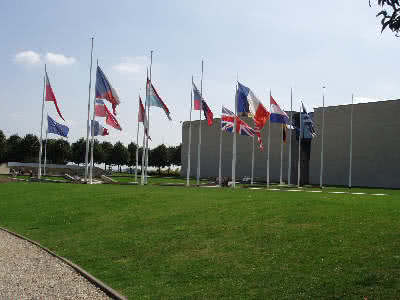
15. Caen Memorial, Normandy
The Caen Memorial is dedicated to explaining the causes and consequences of the Second World War. This can take a couple of hours to visit and many visitors prefer to spend more time visiting the smaller museums and exhibits described above, which give glimpses of the conflict on a human and intimate scale at the spot where it happened.
The Memorial uses displays, models and archive film to explain the causes of the conflict, the Occupation, the Holocaust, D-Day and the aftermath of the war and was revamped in 2010.
16. Canadian Military Cemetery, Cintheaux, Bretteville-sur-Laize, Normandy

The largest Canadian war grave cemetery is situated inland on the road from Caen to Sées at Cintheaux, Bretteville-sur-Laize; this is on the infamous route taken by the retreating German troops, the "Corridor of Death" from Caen to Falaise. Almost every unit of the 2nd Corps is represented here. There are 2,793 Canadian soldiers buried in the cemetery, 91 of them unknown. With them lie 79 members of the R.C.A.F.
17. Falaise Pocket, Montormel - Coudehard, Normandy
The valley between Coudehard and Montormel marks the spot where the Allies finally won the Battle of Normandy; this is the area where the Battle of the Falaise Pocket raged between 18th-22nd August 1944, with 12,000 soldiers killed and heavy casualties among fleeing refugees, as the German forces attempted to retreat towards Paris. The route from Caen to this spot was named the "Corridor of Death" at the time and the area was infested with flies for months afterwards. The 1st Polish Armoured Division succeeded in holding this strategic position despite suffering heavy casualties and repeated assaults by superior German forces.
The hilltop memorial and museum, with armoured vehicles and exhibits describing the battle, is built into the hillside on the spot occupied by the Polish armour and looks down over the valley where the fighting took place.

For your information an extract from Wikipedia on the Normandy conflict is reproduced below.
A brief description of the D-Day Landings
The following is an extract from the Wikipedia account of the D-Day LandingsThe French Resistance
The BBC in its French service from London would regularly transmit hundreds of personal messages. Only a few of them were really significant. A few days before D-Day, the commanding officers of the French Resistance heard the first line of Verlaine's poem, Chanson d'Automne, "Les sanglots longs des violons de l'automne" (Long sobs of autumn violins) which meant that the "day" was imminent. When the second line "Blessent mon coeur d'une langueur monotone" (wound my heart with a montonous langour) was heard, the Resistance knew that the invasion would take place within the next 48 hours. They then knew it was time to go about their respective pre assigned missions, which included destroying selected water towers, telephone lines, roads and railways.
Airborne landings
The British 6th Airborne Division was the first full unit to go into action, at sixteen minutes past midnight, in Operation Tonga. One set of objectives was Pegasus Bridge and other bridges on the rivers at the east flank of the landing area. The bridges were very quickly captured by glider forces and held until relieved by the Commandos later on D-Day. Another objective was a large gun battery at Merville. Although this larger glider and paratroop force was widely scattered, the battery was destroyed. However, the diminished assault team suffered 50% casualties in the attack.
The 82nd (Operation Detroit) and 101st Airborne (Operation Chicago) were less fortunate in quickly completing their main objectives. Partly owing to unmarked landing zones, radio silence, poor weather and difficult terrain, many units were widely scattered and unable to rally. Efforts of the early wave of pathfinder teams to mark the landing zones were largely ineffective. Some paratroopers drowned when they landed in the sea or in deliberately flooded areas. After 24 hours, only 2,500 of the 6,000 men in 101st had assembled. Many continued to roam and fight behind enemy lines for days. The 82nd occupied the town of Sainte-Mère-église early in the morning of June 6, giving it the claim of the first town liberated in the invasion.
Sword Beach
On Sword Beach, the regular British infantry got ashore with light casualties. They had advanced about five miles (8 km) by the end of the day but failed to make some of the deliberately testing targets set by Montgomery. In particular, Caen, a major objective, was still in German hands by the end of D-Day.
1 Special Service Brigade went ashore in the second wave led by No.4 Commando with the two French Troops first, as agreed amongst themselves. The British and French of No.4 Commando had separate targets in Ouistreham: the French a blockhouse and the Casino, and the British two batteries which overlooked the beach. The blockhouse proved too strong for the Commando's PIAT (Projector Infantry Anti Tank) guns, but the Casino was taken with the aid of a Centaur tank. The British Commandos achieved both battery objectives only to find the gun mounts empty and the guns removed. Leaving the mopping-up procedure to the infantry, the Commandos withdrew from Ouistreham to join the other members of 1st SAS Brigade (Nos.3, 6 and 45), in moving inland to join-up with the 6th Airborne.
Juno Beach
The Canadian forces that landed on Juno Beach faced 11 heavy batteries of 155 mm guns and 9 medium batteries of 75 mm guns, as well as machine-gun nests, pillboxes, other concrete fortifications, and a seawall twice the height of the one at Omaha Beach. The first wave suffered 50 percent casualties, the second highest of the five D-Day beachheads.
Despite the obstacles, within hours the Canadians were off the beach and beginning their advance inland. The 6th Canadian Armoured Regiment (1st Hussars) was the only Allied unit to meet its June 6 objectives, when it crossed the Caen-Bayeux highway over nine miles (15 km) inland.
By the end of D-Day, 15,000 Canadians had been successfully landed, and the 3rd Canadian Division had penetrated further into France than any other Allied force, despite having faced such strong resistance at the beachhead. The 21st Panzer division launched the first D-Day counterattack between Sword and Juno beaches, and the Canadians held against several stiff counterattacks by the 12th SS Panzer Division Hitlerjugend on June 7 and 8.
Gold Beach
At Gold Beach, the casualties were also quite heavy, partly because the swimming Sherman DD tanks were delayed, and the Germans had strongly fortified a village on the beach. However, the 50th division overcame its difficulties and advanced almost to the outskirts of Bayeux by the end of the day. With the exception of the Canadians at Juno Beach, no division came closer to its objectives than the 50th. No.47(RM) Commando was the last British Commando unit to land and came ashore on Gold east of Le Hamel. Their task was to proceed inland then turn right (west) and make a ten-mile (16 km) march through enemy territory to attack the coastal harbour of Port en Bessin from the rear. This small port, on the British extreme right, was well sheltered in the chalk cliffs and significant in that it was to be a prime early harbour for supplies to be brought in including fuel by underwater pipe from tankers moored offshore.
Omaha Beach
Omaha Beach was the bloodiest landing beach on D-Day. Elements of the U.S. 1st Infantry Division and U.S. 29th Infantry Division faced the German 352nd Division, one of the best trained on the beaches. Omaha was the most heavily fortified beach, and the pre-landing bombardment (from the Navy and Air Force) of the bunkers had proved to be ineffective. On the Eastern sector, 27 of the 32 DD tanks deployed never reached the beach. On the Western sector the DD's were landed directly on the beach, but suffered heavy losses due to German 88s defending the beach.
The official record stated that "within 10 minutes of the ramps being lowered, the leading company had become inert, leaderless and almost incapable of action (mostly every officer and NCO had been killed or wounded ...). It had become a "struggle for survival and rescue". There were about 1,000 killed (and overall more than 3,000 casualties), most in the first few hours. Commanders considered abandoning the beachhead, but small units, often forming ad hoc groups, eventually took the beach and pressed inland.
Pointe du Hoc
The massive, concrete cliff-top gun emplacement at Pointe du Hoc was the target of the U.S. 2d Ranger battalion. The task of the 225 men, led by Lt. Col. James Earl Rudder, was to scale the 100 foot (30 metre) cliffs under enemy fire with ropes and ladders, and then attack and destroy the guns, which were thought to command the Omaha and Utah landing areas. Only 90 or so of these men survived the onslaught of being picked off by Germans at the top of the cliffs, who bombarded them with grenades, bullets, and even rocks and bottles. The guns, unbeknown to the Rangers, had already been moved to a different position.
Utah Beach
Casualties on Utah Beach, the westernmost landing zone, were 197 out of around 23,000 landed, the lightest of any beach. The U.S. 4th Infantry Division was able to press inland relatively easily and succeeded in linking up with parts of the airborne divisions, which had helped secure the beachhead and distract the enemy before the landings.
